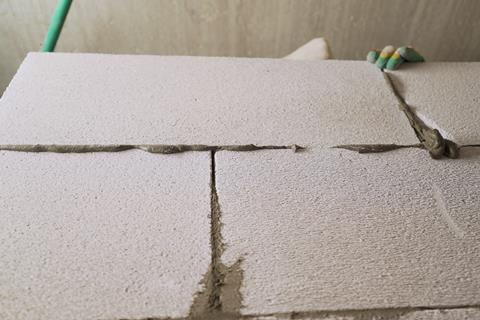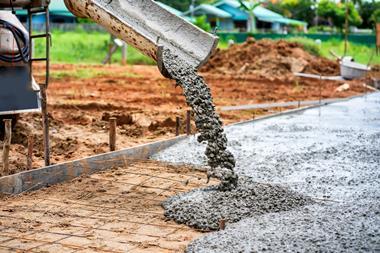Managers of schools, hospitals, courts, theatres and now universities in the UK are urgently reviewing their buildings as the crisis concerning Reinforced Autoclaved Aerated Concrete (RAAC) continues. Shortly before the start of the school term, the government advised education settings to vacate all spaces known to contain RAAC, unless they had mitigations in place to make the building safe. The move caused significant disruption and highlighted the importance of maintaining the structural integrity of buildings over time.
RAAC is a lightweight material typically used in precast panels in buildings erected between the mid-1950s and mid-1990s. ‘We have known about issues with RAAC since about 1992,’ says Phil Purnell, professor of materials and structures at the University of Leeds. ‘The Building Research Establishment produced a report in 1996 that effectively killed any further use in the UK. [However] this was a common building material outside the UK and still is.’
AAC is made from an alkaline mix of materials including cement, calcium hydroxide, fine sand and aluminium powder. Aluminium particles react with the calcium hydroxide to form millions of microscopic hydrogen bubbles which escape and are replaced by air, which makes up 65–80% of the material’s volume. Curing under heat and pressure in an autoclave increases its strength. AAC is less dense than traditional concrete and has a lower compressive strength. Reinforcement, usually with steel bars (rebars), was meant to make it suitable for load-bearing applications.
RAAC was popular in construction because it is light, cheap and easy to mould into panels, says Xiangming Zhou, head of the department of civil and environmental engineering at Brunel University. It’s also a better thermal insulator than traditional concrete.

The problems arise, Zhou notes, when RAAC is used in load-bearing applications such as roof panels. Moisture containing chloride ions can easily penetrate RAAC and reach the rebar’s surface, causing corrosion. Corroded rebars expand and compress the surrounding aerated concrete, which tends to be much more brittle than traditional concrete. This causes cracks which weaken the panels. Because AAC is made with fine aggregates, rather than the coarse ones used in traditional concrete, bonding between rebars and the aerated concrete is much weaker. ‘Therefore, it gives less warning before a catastrophic failure,’ Zhou adds.
The material can fail more suddenly than, for example, steel, timber or traditional concrete, and with very little warning, says Purnell. RAAC planks can be coated with bitumen or similar materials to prevent water getting in. However, if this coating is not maintained, the plank starts to crack.
Alice Moncaster, professor of sustainable construction at the Open University, is also concerned about lack of maintenance. ‘Moisture increases the risk of corrosion. If school buildings and roofs have been poorly maintained due to lack of money, there are likely to be long-term damp problems in walls and ceilings. In addition, last winter saw some exceptionally heavy downfalls. Our changing climate means that many existing buildings are likely to need retrofitting to cope with the new climate.’ She also points out that aerated concrete is more vulnerable to carbonation, where concrete gradually absorbs carbon dioxide from the air. This reduces the pH of the concrete, leading to a higher risk of corrosion for steel reinforcement.
Another issue is the placement of the rebars, says Christian Stone, a technical expert at Concrete Preservation Technologies. ‘When a plank of RAAC is sitting between two beams (bearings) the position of the steel over the beam is vital. The reinforcement gives the RAAC the tensile strength of steel, holding it together in a welded cage when forces try to snap or pull it. What this means is that if the cage of steel is not sitting over the beam supporting the roof plank, when a force is applied there is a risk it will snap (or shear). Therefore, a critical question for engineers is where the steel sits within the plank and how much of the plank is sitting on the beam.’ In some cases, supports may need to be added to these planks. A single failure in the wrong place could be a catastrophe, he adds.
Hundreds of inspections are now underway or planned for buildings built between the mid-1950s and mid-1990s. ‘These buildings do not necessarily need to be demolished and rebuilt,’ says Purnell. ‘But RAAC roof and floor planks/beams will need to be replaced if they are load bearing. The material is well past its design lifetime in most cases; it should have been replaced like timber roof battens and rafters would be periodically replaced, but this was not done. This is a concerning situation, but the root cause is not the material, but poor maintenance and squeezed school budgets.’
In the short term, there are ways to repair and strengthen RAAC elements to extend their life, says Zhou. These include applying a surface render, a dense cementitious coating which would block surface voids and prevent moisture penetrating the concrete; or fibre-reinforced strips to retrofit and strengthen RAAC elements. In the long term, however, Zhou thinks it would be better to rebuild those structural elements made of RAAC because of the weak bonding between rebars and AAC.












No comments yet